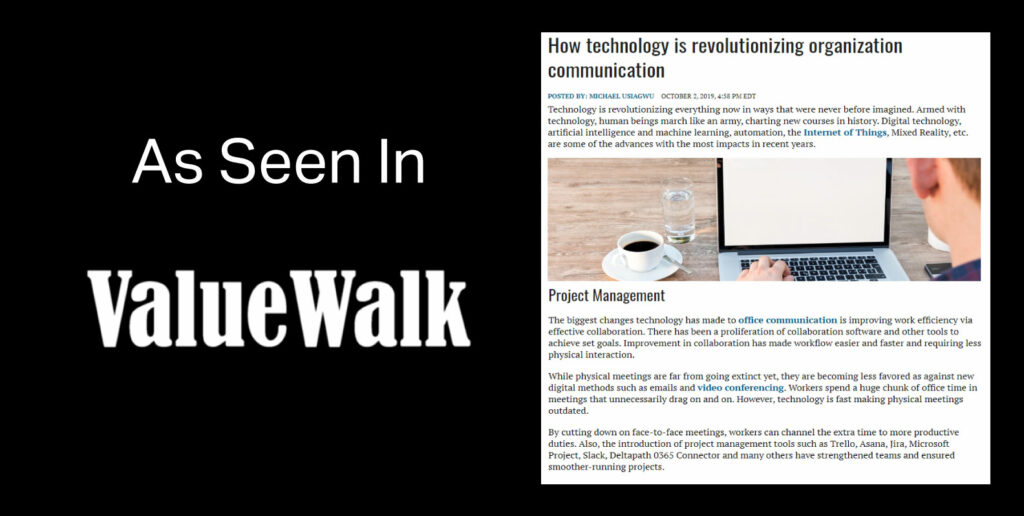
Technology is revolutionizing everything now in ways that were never before imagined. Armed with technology, human beings march like an army, charting new courses in history. Digital technology, artificial intelligence and machine learning, automation, the Internet of Things, Mixed Reality, etc. are some of the advances with the most impacts in recent years.
It is an obvious fact that technology is changing things for the better and making previously arduous tasks go faster and easier. However, beyond buzzwords, how exactly is technology transforming communication within organizations?
Project Management
The biggest changes technology has made to office communication is improving work efficiency via effective collaboration. There has been a proliferation of collaboration software and other tools to achieve set goals. Improvement in collaboration has made workflow easier and faster and requiring less physical interaction.
While physical meetings are far from going extinct yet, they are becoming less favored as against new digital methods such as emails and video conferencing. Workers spend a huge chunk of office time in meetings that unnecessarily drag on and on. However, technology is fast making physical meetings outdated.
By cutting down on face-to-face meetings, workers can channel the extra time to more productive duties. Also, the introduction of project management tools such as Trello, Asana, Jira, Microsoft Project, Slack, Deltapath 0365 Connector and many others have strengthened teams and ensured smoother-running projects.
Remote Working
The decrease in the amount of needed face-to-face interaction is responsible for the rise in remote work. If you can carry out your work and collaborate effectively with other team members without having to be with everyone physically, then there is almost no need to work from a shared office space.
Technology is guaranteeing increased flexibility when it comes to working. Members of a team can be miles away from one another and work would still progress smoothly with the use of project management and video conferencing tools. Therefore, we are seeing a more dispersed workforce in many organizations than we used to have. So far, about 66% of companies have some workers working remotely while another 16% have their entire workforce dispersed.
The rise in remote work also means the elimination of traditional 9-5 working hours. Rather than being bound to a never-changing schedule for years, workers can not only choose to work wherever they want, but also whenever they want. This has likewise given rise to the freelancing and gig-economy. Increasingly, technology is making people work on their own terms, rather than being bound to a single employer.
Easy Access to Information
Technological improvements to communication have led to improved access to relevant information for greater efficiency by workers. With limited technology, the information would usually flow from top-down, and slowly. Apart from the fact that this tells on workplace productivity, there is also the risk of misinformation where some information has to pass through different mouths before finally getting to its intended recipient.
In addition, sometimes, teams are not able to work well because every member has not been brought up to the latest on the project being handled. Technology has changed all these. With the use of technology tools, everyone can be updated at once about the latest development. By sharing the same virtual workspace, entry-level workers have easy access to senior executives and make whatever requests they want.
Workplace communication has moved from a one-way practice (from seniors to juniors) to a two-way practice where the seniors can reach juniors just as much as the latter can reach the former.
Improving Employee Experience
Increasingly, employees are able to feel more connected to the company’s goals and initiatives, and subsequently, more invested in them. Since communication at work has moved from being one-way to dialogues, employees can better understand why certain decisions have to be taken. Apart from that, it gives them the opportunity to share their ideas with the top and feel more valued at work.
Nowadays, an intern can quickly reach the CEO with something they think may help the company. Even if such ideas are eventually not implemented, the feeling of being heard alone boosts the worker’s esteem. The greater an employee believes in the company’s values, the more productive they would be. In all, technology in organizational communication is making for happier employees with greater job satisfaction. This leads to increased commitment to the organization and also to more efficiency.
Conclusion
This fast-paced revolution in communication also means that organizations also have more to do as regards fostering efficient collaboration. As against what used to be the norm, many companies now have internal communications departments, with dedicated directors. That is a step in a good direction as it shows the company prioritizes such an important aspect of work.
The onus lies on the communications unit of each business to come up with a working strategy to improve communication and collaboration at work. This may sometimes vary since each company operates in different ways. In all, an organization that does not take advantage of the latest advancements is sure to fall quickly behind.
